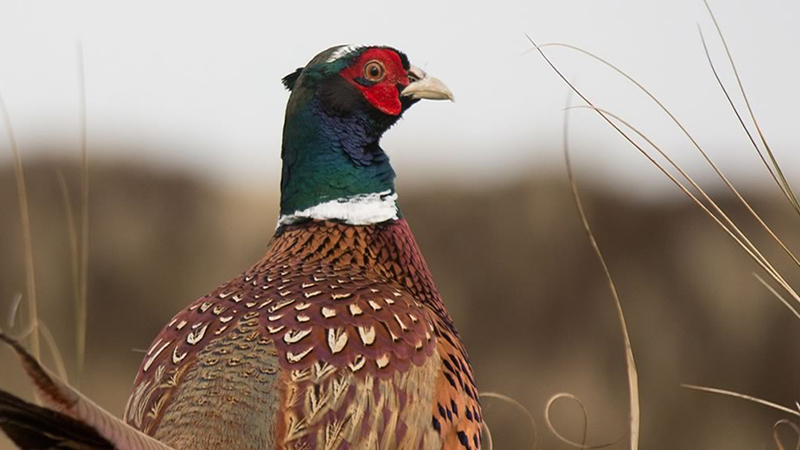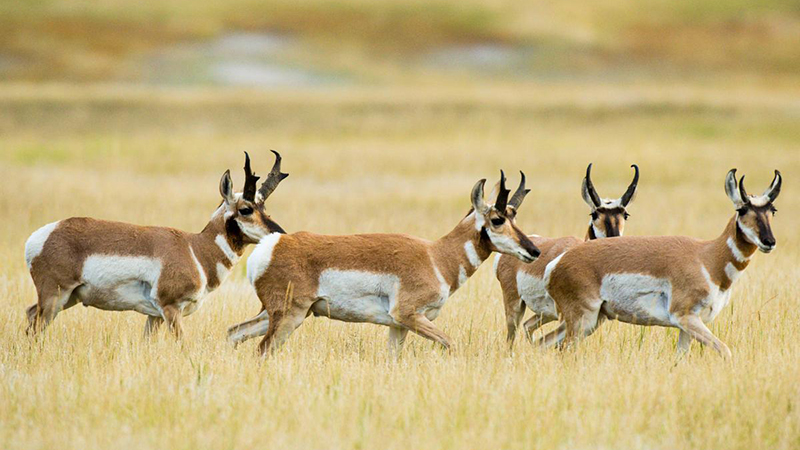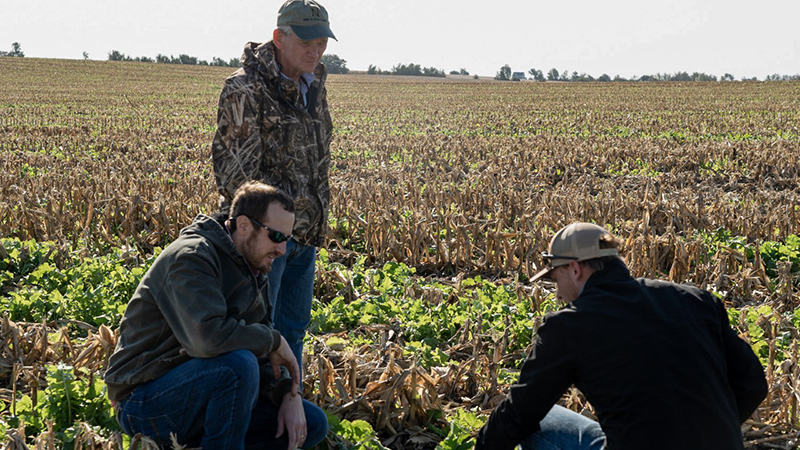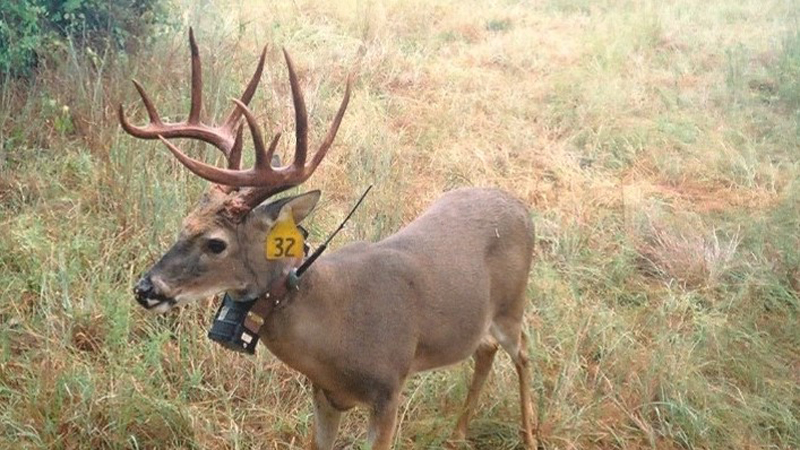Bioenergy Crop Production in an Agricultural Landscape: Implications for Grassland Bird Communities
Agricultural landscapes are facing increasing pressure to produce multiple ecosystem goods and services (Landis 2017). The world’s population is expected to increase by roughly two billion people during the next thirty years, and our society is now facing the challenge of reducing hunger and meeting dietary demands, all in the context of an increasingly changing climate (Spiegal et al 2018). After the financial health of the U.S. farm sector peaked in 2012, income has declined while farm debt has continued to rise (Key 2019). Additionally, U.S. net farm income, an indicator of farm well-being, has decreased by more than $9 billion (or - 12%) from 2017 (U.S. Farm Income Outlook 2018).
Unfortunately, the intensification of agriculture coupled with increased chemical and mechanical inputs has led to negative environmental impacts on soils, water, and biodiversity (Firbank et al. 2008, Stoate et al. 2009, Landis 2017). New precisions technologies and strategic conservation practices offer opportunities to reduce negative environmental impacts while increasing profits. One of the promising conservation practices is the use of cover crops, which is known to promote many aspects of soil and water sustainability (Kaspar & Singer, 2011; Chatterjee, 2013). Placing these cover crops in areas with less productivity can increase overall cropland profitability while promoting wildlife habitat and diversity. However, perennial grassland cropping systems are uncommon across the Midwest due to technological and commercial challenges associated with conversion of grass biomass to bioenergy (Mitchell et al. 2012). There is a critical need to improve our knowledge on how perennial grassland copping systems influence avian species richness. A limited amount of information exists on the influence that perennial grassland species types have on the amount of avian species richness in an agriculture landscape. With this new information, grassland bird conservation in agricultural-dominated landscapes can improve while increasing overall cropland profitability.
Our research will evaluate two specific aims:
- Do perennial grassland cropping systems influence avian species richness?
- Does landscape context influence avian species richness within and around perennial grassland cropping systems?
Identifying and Prioritizing Habitat for Pheasant Conservation and Management in Agriculturally Dominated Landscapes

Many avian species, including ring-necked pheasant (Phasianus colchicus; hereafter ‘pheasant’) and northern bobwhite (Colinus virginianus), have declined in agriculturally dominated landscapes (Sauer et al. 2003, Sauer et al. 2011). To reverse this decline, state wildlife agencies have prioritized enrolling private lands in conservation programs (e.g., State Acres for Wildlife Enhancement, Conservation Program 33-Habitat Buffers for Upland Birds) with the goal of increasing available wildlife habitat. These programs have slowed the decline of many wildlife species in agriculturally dominated landscapes (Best et al. 1997, Ryan et al. 1998, Haufler 2005, Hiller et al 2015), but pheasant populations continue to decline in many areas (e.g., Rodgers et al. 1999, Jorgenson et al. 2014).
One of the primary drivers of this decline is the intensification of agricultural production that has resulted in a simplification of agricultural systems (e.g., monocultures of high-yielding crops, increased field sizes, and removal of non-crop habitat to maximize production (Bianchi et al. 2006, Hijimans et al. 2016), and is expected to increase during the next 50+ years as human population and nutritional demands increase (Tillman et al. 2011, Nelson et al. 2018). Another primary driver of this decline is the scattered implementation of suitable habitat across the landscape (Weber et al. 2002). This is partially due to limited financial resources available for conservation efforts (Naidoo et al. 2006), but also due to a lack of land-prioritization techniques for optimal wildlife benefits (Weber et al. 2002).
Another common issue is the lack of understanding about the ‘scale of effect’ that pheasant populations respond to environmental change (e.g., Miguet et al. 2016, Yeiser et al. 2018). For example, in Kentucky, researchers identified that Conservation Reserve Enhancement Program (CREP) fields >5,000 m apart had no effect on local northern bobwhite abundance. Additionally, pheasant nest survival in southwest Nebraska increased as the amount of CRP, winter wheat, and pastureland surrounding a CRP field increased, whereas increasing fallow fields was correlated with decreased nest success; patch context can also influence nest survival and success (Simonsen and Fontaine 2016). These examples illustrate the importance of spatial distribution of patches at a local spatial scale on gamebird population abundance. Therefore, state wildlife agencies require innovative approaches that strategically target the implementation of habitat for more heterogeneous landscapes at spatial scales capable of sustaining wildlife populations.
Our research objectives are:
- determine minimum habitat thresholds and configurations (i.e., spatial arrangements) to support pheasant populations;
- estimate the ‘scale of effect’ at which pheasant populations respond to spatially targeted land management; and examine how pheasant populations respond regionally to increases or decreases in suitable habitat in different configurations to direct future conservation efforts;
- forecast pheasant population densities under varying levels of suitable pheasant habitat availability using a modeling and structured decision-making (SDM) framework;
- develop a user-friendly science literacy website to disseminate our research and other upland game bird research to a variety of stakeholders.
Pronghorn Movement Ecology and Resources Selection in the Nebraska Panhandle

Grasslands of North America are one of the most threatened ecosystems in the world (Forrest et al. 2004). These grasslands are commonly converted to agricultural crops, infrastructure (e.g., roads, cities, urban sprawl), and energy development (Forrest et al. 2004, Pool et al. 2014). Unfortunately, grassland conversions have negatively impacted biodiversity, primarily due to the loss of habitat and increased landscape fragmentation (Ceballos et al. 2010). To slow the decline in biodiversity, grassland landscapes must be managed effectively to maximize biodiversity retention, while providing sufficient agricultural and energy outputs to meet current and future demands. An important big game species found in this grassland community is the American pronghorn (Antilocapra americana).
While Nebraska pronghorn populations have fluctuated throughout the 1900s due to changes in land-use and hunting regulations (Jones 1964, Hoffman et al. 2010), the Sandhills remain relatively intact and hospitable to pronghorns, and populations of pronghorn currently persist in western and north-central Nebraska. While cattle ranching has been the primary land use in western Nebraska since the 1800s, certain portions of the region are managed for hay production and row crops, and much of the historical pronghorn habitat in western Nebraska has been converted to agricultural fields (Hiller et al. 2009). Crop depredation is also a challenge for land managers with pronghorn spending considerable time in alfalfa and wheat fields compared to native rangeland (Griffin 1991). Thus, there is a critical need to improve our knowledge on pronghorn movement ecology and resource selection in the Nebraska Panhandle. In the absence of such information, understanding the impacts of habitat fragmentation and landscape permeability on pronghorn spatial ecology will likely remain difficult.
Our long-term goal is to establish effective management strategies for pronghorn in the Nebraska Panhandle. Specifically, our research will focus on: 1) identifying critical ranges, migration corridors, habitat use, and temporal-spatial distributions of male and female pronghorn; and 2) evaluating survival of adult pronghorn. This research is a collaborative effort with Nebraska Game and Parks Commission and the Ranglack Lab (www.ranglacklab.com/).
Targeted conservation survey of farmers awarded Nebraska Environmental Trust funding

The Nebraska Environmental Trust recently awarded 21 grants totaling over $1.9 million to University of Nebraska-Lincoln projects, including several housed at the School of Natural Resources. The SNR projects include an effort to survey farmers about their willingness to participate in targeted conservation projects. The $104,971 grant was awarded to project lead Andrew Little, Assistant Professor of Landscape Ecology and Habitat Management.
In the proposal, Little wrote that agricultural producers in Nebraska have trended toward maximizing crop production by way of increasing field sizes, reducing crop diversity and removing non-crop habitat on farmland. Though farm productivity has increased in many instances, the process of devoting more land to fewer crop varieties leaves rural and urban residents susceptible to emerging environmental concerns (water pollution and soil erosion, for example) and economic uncertainties.
In an effort to mitigate those concerns, researchers have developed new precision technology and conservation planning frameworks that strategically target low-yielding acres for alternative management options while farming high-yielding acres in an effort to optimize agricultural production and natural resource conservation. This approach helps farmers and farmland owners increase whole-field profitability while reducing environmental impacts. To understand Nebraska farmers and farmland owners' willingness to participate in such targeting schemes, Little and his research team will identify key factors that facilitate or constrain their participation through socio-economic and behavioral surveys, focus groups and phone interviews. With this information, Nebraska conservation agencies and/or organizations can develop a coordinated effort to work with farmers and farmland owners to reduce environmental impacts while increasing whole-field profitability.
The Nebraska Legislature created the Nebraska Environmental Trust in 1992. Using revenue from the Nebraska Lottery, the Trust has provided over $328 million in grants to over 2,300 projects across the state. Anyone – citizens, organizations, communities, farmers and businesses – can apply for funding to protect habitat, improve water quality and establish recycling programs in Nebraska. The Nebraska Environmental Trust works to preserve, protect and restore our natural resources for future generations.
Landscapes of Fear: Identifying Successful Hunting Strategies to Effectively Manage White-tailed Deer Populations

With an increasingly human-dominated landscape, human predation risk caused by recreational hunting may play an important role in behavioral modification of ungulate populations (Laliberte and Ripple 2004). For example, deer modified their behavior to avoid detection by hunters (Little et al. 2011, Little et al. 2014, Little et al. 2016, Marantz et al. 2016). Despite deer modifying their behaviors to avoid detection, some hunters are relatively consistent at harvesting deer annually, which suggests an underlying behavioral strategy may affect their ability to be successful hunters. Currently, a knowledge gap exists in our understanding of how hunting strategies (e.g., hunting style, hunter movements, etc.) affect observation rates of white-tailed deer (a surrogate to harvest susceptibility). Thus, there is a critical need to identify the successful behaviors of hunters to achieve population management goals through harvest. In the absence of such information, improving deer population management in increasingly human-dominated landscapes with overabundant deer populations will likely remain difficult.
This research project is being conducted in collaboration with the Ranglack Lab (Dr. Dustin Ranglack; http://www.ranglacklab.com/; University of Nebraska-Kearney), Applied Wildlife Spatial Ecology Lab (Dr. Andrew Little; https://wildlifeecologylab.unl.edu/; University of Nebraska-Lincoln), and the Noble Research Institute (Dr. Stephen Webb; https://www.noble.org/staff/stephen-webb/). Our research will leverage an existing data set of 37 adult, male white-tailed deer (locations collected every 8 minutes), >50 hunters with GPS units (locations collected every 30 seconds), and hunter observational information
Our research will specifically evaluate:
- behavior of hunters (e.g., hunting style, hunter movements, spatial attributes of hunting sites, etc.)
- how hunter behavior influences their probability of observing deer
- how hunter behavior structures risk in white-tailed deer